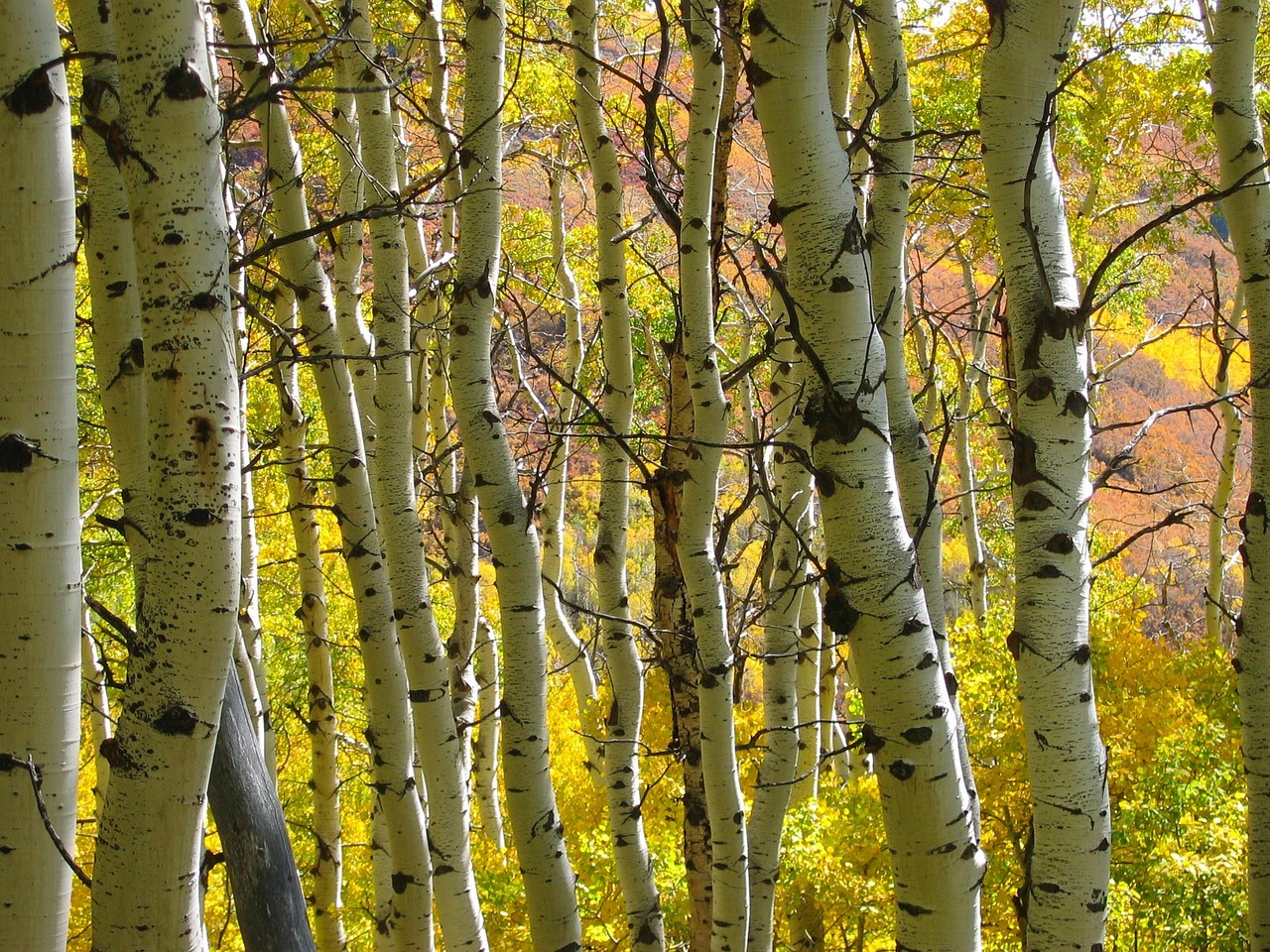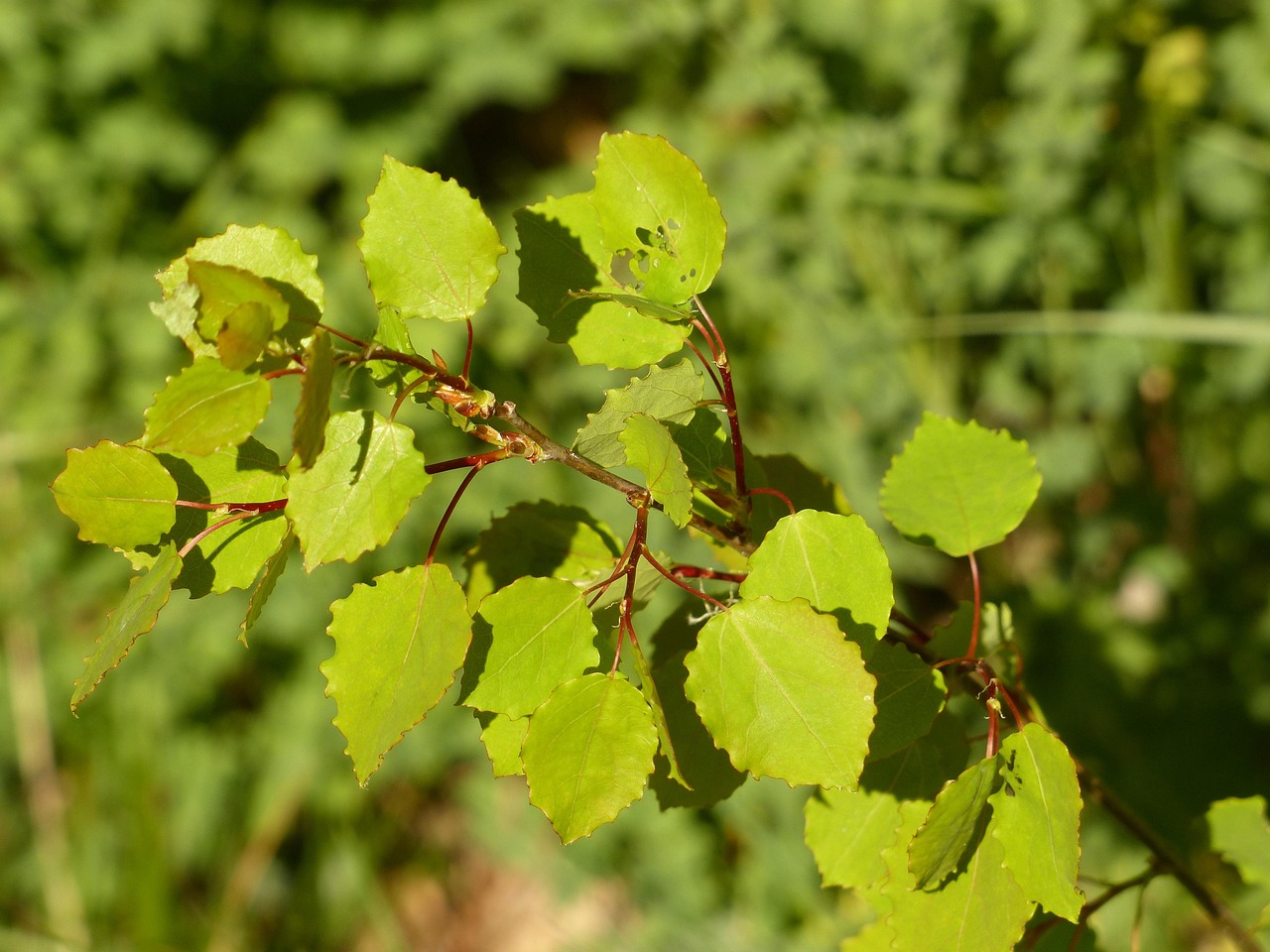Quaking aspen trees (Populus tremuloides) exhibit an impressive growth rate, reaching heights of 20-80 feet within 10-25 years. They often form clonal colonies, allowing them to spread rapidly through suckering, creating a network of genetically identical trees.
Understanding Quaking Aspen Trees
The quaking aspen is a deciduous tree native to North America. Known for its striking white bark and vibrant yellow foliage in autumn, it thrives in diverse environments. This tree species is particularly notable for its ability to form extensive clonal colonies. These colonies arise from a single root system, enabling them to spread efficiently across the landscape.

One of the defining features of quaking aspen is its rapid growth rate. Under optimal conditions, these trees can grow between 1.5 to 3 feet annually. Factors influencing their growth include soil quality, sunlight exposure, and water availability. In healthy ecosystems, quaking aspens can live for 30 to 150 years, although some clonal colonies may persist for thousands of years.
Growth Rate Factors
Several factors influence the growth rate of quaking aspen trees. Understanding these elements can help in managing their populations effectively. Key factors include:
- Soil Quality: Nutrient-rich, well-drained soils promote faster growth.
- Water Availability: Adequate moisture is crucial for healthy development, especially in the early years.
- Sunlight Exposure: Full sunlight enhances photosynthesis, leading to quicker growth.
- Climate: Aspen trees thrive in temperate climates with cold winters and warm summers.
The adaptability of quaking aspens allows them to thrive in various environments, from mountainous regions to flat plains. However, they tend to prefer locations with plenty of sunlight and access to water sources.

Clonal Colonies: An Overview
Quaking aspens are unique among tree species due to their capacity for clonal reproduction. This process occurs when new shoots emerge from the root system of an established tree. These shoots develop into genetically identical trees, forming what is known as a clonal colony.
This method of reproduction provides several advantages:
- Resilience: Clonal colonies can survive adverse conditions, such as disease or fire, through their interconnected root systems.
- Resource Sharing: Trees within a colony share resources like water and nutrients, promoting overall health.
- Rapid Expansion: Clonal growth allows for quick colonization of available land, enabling aspens to dominate certain areas.
The largest known living organism on Earth is a clonal colony of quaking aspens known as “Pando” located in Utah. This colony covers over 100 acres and consists of approximately 47,000 individual trees, all genetically identical and connected by a single root system.

Importance of Clonal Colonies
The presence of clonal colonies plays a crucial role in maintaining ecological balance. Quaking aspens serve as a keystone species in many forest ecosystems. They provide habitat and food for various wildlife, including birds, mammals, and insects. The trees also contribute to soil stabilization and improve the overall health of the forest by supporting biodiversity.
Moreover, clonal colonies can significantly influence forest dynamics. When disturbances occur, such as fire or logging, these colonies often regenerate quickly, helping to restore the ecosystem. Their ability to sprout new shoots from the roots allows them to take advantage of available sunlight and space left by other species.
Challenges Facing Quaking Aspen Populations
Despite their resilience, quaking aspen populations face numerous challenges. Climate change is affecting their habitats, leading to shifts in growth patterns and ranges. Additionally, diseases like fungal infections and pests such as the aspen leaf miner pose threats to their health and longevity.
Conservation efforts are essential to protect these unique trees and their habitats. Monitoring their growth rates, understanding their ecological roles, and managing threats can help ensure that quaking aspens continue to thrive in North America.

Growth Rate Variability in Quaking Aspens
The growth rate of quaking aspens is not uniform. Various factors contribute to this variability, resulting in different growth patterns across regions. Understanding these factors is crucial for managing and conserving these trees effectively.
Environmental Influences
Quaking aspen growth rates can be significantly influenced by environmental conditions. Some of the primary factors include:
- Elevation: Higher elevations typically have shorter growing seasons and harsher conditions, which can slow growth.
- Soil Composition: Soils rich in organic matter and nutrients favor faster growth rates compared to sandy or rocky soils.
- Moisture Levels: Areas with consistent moisture support better growth than those experiencing drought conditions.
- Temperature: Warmer temperatures can enhance growth during the growing season, while extreme cold can hinder development.
Different regions where quaking aspens grow may exhibit distinct growth patterns due to these environmental factors. For example, aspens in the Rocky Mountains may grow slower than those found in lower elevation areas with more favorable growing conditions.
Impact of Competition
Competition with other plant species also plays a vital role in the growth rate of quaking aspens. When they grow in dense forests, they may face competition for light, water, and nutrients. The presence of other tree species can impede their growth. Key competitors include:
- Pines: Pine trees often outcompete aspens for sunlight, especially in early stages of growth.
- Spruces: Similarly, spruce trees can shade aspens, limiting their access to critical resources.
- Other Deciduous Trees: Species like oaks and maples may compete with aspens, affecting their overall health and growth rate.
Effective forest management practices can help reduce competition and promote healthier aspen populations. Thinning overcrowded areas allows more light to reach the aspens and can enhance their growth potential.
Reproductive Strategies of Quaking Aspens
Quaking aspens have developed unique reproductive strategies that contribute to their survival and expansion. These strategies include both sexual and asexual reproduction, each playing a different role in their life cycle.
Asexual Reproduction
Asexual reproduction through clonal growth is the most common method for quaking aspens. This process involves:
- Suckering: New shoots emerge from the root system of an existing tree, allowing for the development of genetically identical offspring.
- Root Sprouting: Roots that extend horizontally can produce new shoots at various distances from the parent tree, enabling the colony to expand over time.
- Rapid Growth: The ability to sprout quickly from established roots helps colonize areas after disturbances.
Sexual Reproduction
While asexual reproduction is predominant, quaking aspens also reproduce sexually through pollination. The key aspects include:
- Flowering: Quaking aspens produce catkins, which are clusters of tiny flowers that bloom in spring.
- Pollination: Wind pollinates these flowers, allowing for the production of seeds.
- Seed Dispersal: Seeds are lightweight and can be carried by the wind over long distances, leading to new colonies forming far from the parent tree.
The combination of both reproductive methods provides quaking aspens with a robust strategy for survival. Asexual reproduction ensures rapid colonization, while sexual reproduction allows for genetic diversity and adaptation to changing environmental conditions.
Growth Rate Measurement Techniques
<pTo understand and monitor the growth rates of quaking aspens accurately, researchers employ various measurement techniques. These methods help in assessing the health of aspen populations and their response to environmental changes. Common techniques include:
- Dendrochronology: This method involves studying tree rings to determine growth rates over time. Each ring represents a year of growth, allowing researchers to analyze historical growth patterns.
- Height Measurement: Measuring the height of individual trees at regular intervals provides direct information about their growth rates.
- Diameter at Breast Height (DBH): This standard measurement tool assesses the thickness of a tree trunk at 4.5 feet above ground level, providing insights into overall health and age.
The results gathered from these techniques are invaluable for forest management and conservation efforts. They help determine which areas require intervention or protection based on the health and growth rates of quaking aspen populations.
Ecological Significance of Quaking Aspens
Quaking aspens play a crucial role in their ecosystems. Their unique traits contribute to a variety of ecological functions, supporting both plant and animal life. Understanding these roles helps highlight the importance of conserving aspen populations.
Habitat for Wildlife
Quaking aspens provide habitat and food for numerous wildlife species. Their presence in forests supports a diverse range of animals, including:
- Mammals: Species such as deer, elk, and moose often feed on the tender leaves and bark of young aspen trees.
- Birds: Many bird species, including woodpeckers and songbirds, utilize aspen trees for nesting and foraging.
- Insects: As a food source, aspens support various insects, which in turn attract birds and other predators.
The interconnectedness of aspens with wildlife highlights their importance in maintaining biodiversity within forest ecosystems. Their ability to thrive in different habitats makes them a vital component of many North American environments.
Soil and Water Conservation
Quaking aspens contribute significantly to soil health and water conservation. They help stabilize soil with their extensive root systems, which reduces erosion and enhances water retention. Key benefits include:
- Soil Structure: The root systems of quaking aspens create channels that improve soil aeration and drainage.
- Nutrient Cycling: Fallen leaves from aspens decompose, enriching the soil with organic matter and nutrients.
- Water Retention: Their presence can increase moisture levels in the surrounding environment, benefiting other plant species.
This ability to improve soil quality and water availability supports a healthier ecosystem, fostering growth for various plants and enhancing wildlife habitats.
Management Practices for Quaking Aspen Conservation
Effective management practices are essential for conserving quaking aspen populations. These practices aim to ensure that these trees continue to thrive in changing environmental conditions. Some key strategies include:
Monitoring Aspen Health
Regular monitoring of aspen populations is vital for detecting changes in health and growth rates. Effective monitoring strategies involve:
- Aerial Surveys: Utilizing aerial photography or drones to assess large areas for changes in forest cover and health.
- Ground Surveys: Conducting on-the-ground assessments to measure tree height, diameter, and overall health.
- Data Collection: Gathering data on pest populations and disease incidence to address potential threats early.
Sustainable Harvesting Practices
Sustainable harvesting practices help maintain healthy aspen populations while allowing for economic benefits. These practices include:
- Selectively Thinning: Removing certain trees to reduce competition while promoting the growth of remaining aspens.
- Controlled Burns: Implementing prescribed burns to manage undergrowth and encourage new growth in aspen stands.
- Avoiding Clear-Cutting: Rather than clear-cutting entire areas, selective logging preserves the genetic diversity and integrity of aspen colonies.
By applying these sustainable techniques, forest managers can balance ecological health with economic needs, ensuring quaking aspens remain a thriving part of the landscape.
Research Advances in Quaking Aspen Studies
Ongoing research into quaking aspens continues to reveal important insights about their biology and ecology. Recent studies focus on various aspects, including genetics, climate adaptability, and forest dynamics. Some notable research areas include:
- Genetic Diversity: Investigating the genetic variation within clonal colonies helps understand their resilience to diseases and environmental changes.
- Climate Change Impact: Researching how changing climate conditions affect growth rates and distribution patterns of quaking aspens can inform conservation strategies.
- Ecosystem Interactions: Studying the interactions between aspens and other species helps clarify their roles within the broader ecosystem.
This research contributes to a deeper understanding of quaking aspens, paving the way for innovative management practices that support their survival amid environmental challenges.
The Role of Community Engagement
Community engagement plays a significant role in the conservation of quaking aspens. Educating the public about their ecological importance fosters a sense of responsibility toward preserving these valuable trees. Engaging communities can take several forms:
- Awareness Campaigns: Informational campaigns that highlight the significance of quaking aspens can motivate people to participate in conservation efforts.
- Volunteer Programs: Organizing tree planting and maintenance events allows community members to contribute directly to aspen conservation.
- Collaboration with Local Organizations: Partnering with environmental groups can enhance resources and expertise dedicated to preservation efforts.
By fostering community involvement, it becomes possible to create a collective effort aimed at protecting quaking aspen populations for future generations.
Future Directions for Quaking Aspen Research
As we look to the future, research on quaking aspens is expected to expand, addressing emerging challenges and opportunities. Several key areas of focus are anticipated:
- Climate Resilience Studies: Ongoing research will explore how quaking aspens can adapt to changing climate conditions. Identifying genetic traits that confer resilience can help in conservation efforts.
- Restoration Ecology: Studies will continue to develop methods for restoring degraded aspen habitats, ensuring their persistence in ecosystems affected by human activity and climate change.
- Pest and Disease Management: Understanding the interactions between quaking aspens and pests, as well as disease dynamics, will be critical in developing strategies to protect these trees.
- Carbon Sequestration Research: Investigating the role of quaking aspens in carbon storage can enhance our understanding of their contribution to mitigating climate change.
Investments in these research areas will not only deepen our understanding of quaking aspens but also inform effective management and conservation practices that benefit entire ecosystems.
Community Involvement in Conservation
Community involvement is essential for the long-term conservation of quaking aspens. Engaging local communities helps foster a culture of stewardship, encouraging individuals to take an active role in preserving their natural environments. Initiatives may include educational workshops, guided nature walks, and citizen science projects.
Educational programs in schools can raise awareness among younger generations about the importance of quaking aspens. By integrating environmental education into school curricula, educators can instill values of conservation early in life, promoting an understanding of ecological relationships and the significance of biodiversity.
Encouraging Responsible Land Use Practices
Responsible land use practices are crucial for the preservation of quaking aspen populations. Promoting sustainable forestry practices, limiting urban sprawl, and protecting natural habitats are essential steps that communities can take. Local governments can play an important role by enacting regulations that safeguard aspen forests from development pressures.
Additionally, landowners can be educated about the benefits of maintaining healthy aspen stands on their properties. By providing incentives for conservation-friendly practices, such as tax breaks or grants for reforestation efforts, communities can encourage landowners to prioritize the preservation of these vital ecosystems.
Final Thoughts
Quaking aspens are more than just beautiful trees; they are integral components of their ecosystems that provide numerous ecological benefits. Their rapid growth rates and ability to form extensive clonal colonies make them unique among tree species. Understanding their significance helps underscore the need for conservation efforts aimed at preserving both individual trees and entire populations.
The challenges faced by quaking aspens—including climate change, pests, and habitat loss—require a multi-faceted approach to conservation. By combining scientific research with community engagement, we can promote healthier aspen populations and ensure their survival for future generations. The collaboration between scientists, policymakers, and local communities is essential to create effective conservation strategies that protect these remarkable trees.
As we move forward, it is imperative to cultivate a deeper appreciation for quaking aspens and their role in maintaining ecological balance. Through continued research, community initiatives, and responsible management practices, we can foster a sustainable future where quaking aspens thrive alongside the diverse wildlife they support.
